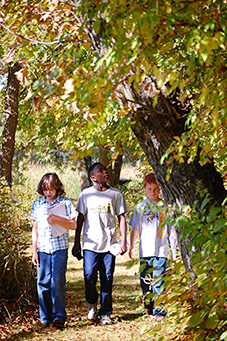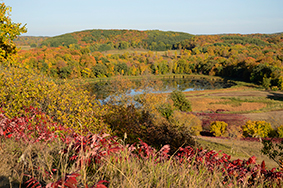July may get all the glory for its patriotic displays of fireworks, but when it comes to a true explosion of colors, it’s tough to beat the show put on each year by September and October.
As the days get shorter and the nights grow cool, trees undergo chemical changes that cause them to swap their summer greenery for the fiery hues of fall. It’s a process that turns even the daily drive to work into a breathtaking excursion, while providing a forceful reminder of nature’s complex workings.
Tree leaves may look like mere ornaments clustered on branches, but they’re actually miniature solar collectors and food factories. In a process known as “photosynthesis,” substances inside the leaves use sunlight to turn water and carbon dioxide from the air into sugars that feed the tree. The chemical mainly responsible for capturing the sun’s energy and putting it to work this way is a green pigment called chlorophyll. It’s what makes leaves green throughout the growing season. When the amount of sunlight decreases as the days shorten, photosynthesis slows, the tree quits making chlorophyll, and what’s left breaks down, taking the green color with it.
But the green chlorophyll isn’t the only show going on inside the leaves. It’s just a bit of an attention hog, overpowering other chemicals that produce other colors. When the green fades those other hues can shine through. Chemicals known as carotenoids produce the bright yellows and oranges seen on trees like elm, birch and maple. Shades of red and purple, seen on dogwoods and sumac, are produced by anthocyanins, and tannins give rise to the brown leaves of oak trees.
Fall colors vary from year to year largely as a result of weather, both in the fall and during the growing season that precedes it. A growing season with ample rain and warm weather, followed by a sunny, dry autumn with cool frostless nights and warm days will produce the best display. Fall rain and cloudy skies can result in muted colors, while heavy winds will cause the leaves to drop early.
With the leaves no longer providing a useful service to the tree after photosynthesis shuts down, a brittle, corky layer of cells begins to form where the leaves attach to the tree. Wind, rain and gravity soon conspire to separate the leaves from the tree, producing occasional blizzards of color as they fall to the ground. In forested areas, the fallen leaves provide habitat for insects and small animals before rotting and enriching the soil, which then feeds the trees and other plants in the great cycle of life.
This fall, before the leaves in your yard turn into just another weekend chore, take some time to appreciate the visual feast nature provides. Go for a drive along one of the region’s big rivers, like the Mississippi, the Minnesota or the St. Croix to enjoy the panoramic scenery. Visit a park. Take a walk in the woods and try to catch a brightly colored leaf as it spirals down from above. Pause for a moment to reflect on what’s around you, and how, as French author Albert Camus said, “Autumn is a second spring, when every leaf is a flower.”
Enjoy Fall With The Minnesota DNR
You can keep track of fall colors and how the leaves are changing from north to south by checking out the Minnesota Department of Natural Resources’ Fall Color Finder at www.mndnr.gov/fall_colors.
Many Minnesota State Parks offer programs highlighting the natural processes of fall, including:
- Fall Color Walk – Sept. 28, 9 to 10:30 a.m., Brown’s Creek State Trail (Stillwater trailhead)
- Fall Color Walk – Oct. 5, 1 to 2:30 p.m., Wild River State Park
- Autumn Color Walk – Oct. 12, 1 to 3 p.m., Afton State Park
Get more information about these and other events at www.mndnr.gov/state_parks/events.html













